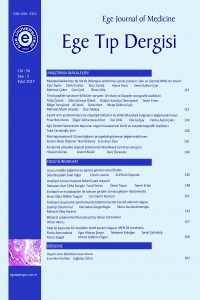Abstract
Androgen insensitivity syndrome, previously referred to as testicular feminization syndrome, is an X-linked recessive disorder that is characterized by a mutation in the q11-q12 region of the X chromosome, which results in a deformed androgen receptor gene. Patients with androgen insensitivity syndrome may develop testicular tumors, especially seminomas after puberty. A 35-year-old female patient presented with the complaint of primary amenorrhea and had masses of approximately 4 cm size palpated in the bilateral inguinal regions. The masses were excised and the histopathological examination was reported as bilateral Sertoli cell adenoma. Although the risk of bilateral gonadal tumor development is low in patients with androgen insensitivity syndrome, such malignancies should not be disregarded.
References
- Siminas S, Kokai G, Kenny SE. Complete androgen insensitivity syndrome associated with bilateral Sertoli cell adenomas and paratesticular leiomyomas: Case report and review of the literature. J Pediatr Urol 2013;9(1):31-4.
- Hughes IA, Deeb A. Androgen resistance. Best Pract Res Clin Endocrinol Metab 2006;20(4):577-98
- Baksu A, Kabukcuoglu F, Baksu B, Goker N. Bilateral Sertoli cell adenoma and serous cyst in a patient with androgen insensitivity syndrome. Europ Jour of Obst and Gynand Reproductive Biol 2004;114(1):104-7.
- Cools M, Drop SLS, Wolffenbuttel KP, Oosterhuis JW, Looijenga LH. Germ cell tumours in the intersex gonad: Old paths, new directions, moving frontiers. Endocr Rev 2006;27(5):468-84.
- Boehmer AL, Brinkmann O, Brüggenwirth H, et al. Genotype versus phenotype in families with androgen insensitivity syndrome. J Clin Endocrinol Metab 2001;86(9):4151-60.
- Fallat ME, Donahoe PK. Intersex genetic anomalies with malignant potential. Curr Opin Pediatr 2006;18(3):305-11.
- Bouvattier C. Androgen receptor defects: Syndromes of androgen insensitivity. Disorders of sex development: endocrine aspects. In: Gearhart, Rink, Mouriquand, editors. Pediatric Urology. 2nd ed. Philadelphia: Saunders Elsevier; 2010:472-3.
- Slijper FM, Frets PG, Boehmer AL, Drop SL, Niermeijer MF. Androgen insensitivity syndrome(AIS): Emotional reactions of parents and adult patients to clinical diagnosis of AIS and its confirmation by androgen receptor gene mutation analysis. Horm Res 2000;53(1):9-15.
- Vega IF, Juanes JS, Pravia CG. Bilateral Sertoli cell adenoma in gonads, associated with serous cystadenoma. Pol J Pathol 2014;65(2):154-6.
Abstract
References
- Siminas S, Kokai G, Kenny SE. Complete androgen insensitivity syndrome associated with bilateral Sertoli cell adenomas and paratesticular leiomyomas: Case report and review of the literature. J Pediatr Urol 2013;9(1):31-4.
- Hughes IA, Deeb A. Androgen resistance. Best Pract Res Clin Endocrinol Metab 2006;20(4):577-98
- Baksu A, Kabukcuoglu F, Baksu B, Goker N. Bilateral Sertoli cell adenoma and serous cyst in a patient with androgen insensitivity syndrome. Europ Jour of Obst and Gynand Reproductive Biol 2004;114(1):104-7.
- Cools M, Drop SLS, Wolffenbuttel KP, Oosterhuis JW, Looijenga LH. Germ cell tumours in the intersex gonad: Old paths, new directions, moving frontiers. Endocr Rev 2006;27(5):468-84.
- Boehmer AL, Brinkmann O, Brüggenwirth H, et al. Genotype versus phenotype in families with androgen insensitivity syndrome. J Clin Endocrinol Metab 2001;86(9):4151-60.
- Fallat ME, Donahoe PK. Intersex genetic anomalies with malignant potential. Curr Opin Pediatr 2006;18(3):305-11.
- Bouvattier C. Androgen receptor defects: Syndromes of androgen insensitivity. Disorders of sex development: endocrine aspects. In: Gearhart, Rink, Mouriquand, editors. Pediatric Urology. 2nd ed. Philadelphia: Saunders Elsevier; 2010:472-3.
- Slijper FM, Frets PG, Boehmer AL, Drop SL, Niermeijer MF. Androgen insensitivity syndrome(AIS): Emotional reactions of parents and adult patients to clinical diagnosis of AIS and its confirmation by androgen receptor gene mutation analysis. Horm Res 2000;53(1):9-15.
- Vega IF, Juanes JS, Pravia CG. Bilateral Sertoli cell adenoma in gonads, associated with serous cystadenoma. Pol J Pathol 2014;65(2):154-6.
Details
| Primary Language | English |
|---|---|
| Subjects | Health Care Administration |
| Journal Section | Case Report |
| Authors | |
| Publication Date | September 1, 2017 |
| Submission Date | August 2, 2016 |
| Published in Issue | Year 2017 Volume: 56 Issue: 3 |
Ege Journal of Medicine enables the sharing of articles according to the Attribution-Non-Commercial-Share Alike 4.0 International (CC BY-NC-SA 4.0) license.

